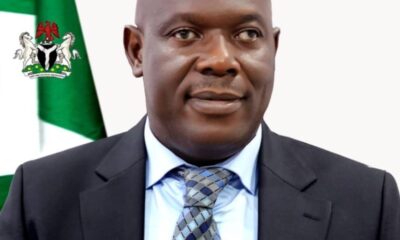Opinion
Today’s Nigeria
Nigeria is a country that has witnessed many political dispensations. Some were good, others were either bad or downright bizarre.
The complex nature of the emergence of these dispensations has made many lose count of the number of republics that have existed since the 1963 Republican constitution after the independence of 1960.
The present political dispensation in Nigeria which began in 2015 has called for deep reflections and uneasy restiveness among citizens.
At a time like this when every indices of good governance in Nigeria drops on the lower scale of assessment, it is good to do a verification check so that those who are at the helm of affairs, especially at the center, can do a dental Arithmetic by using their tongue to count their teeth. Let us see where the rain began to beat us since we have been complaining about the awful rain storm of woes in the governance of our dear country.
Good governance is measured by Human Development index of a country.
H.D. I. recognises the level of educational development of a country, life expectancy, health, infant mortality, as well as poverty index.
Where is the place of Nigeria on these measures of development?
At the level of Education, the nation’s budget on Education is still below the United Nations average of twenty six percent of total budget. The present out of school dropout rate is worse than 10 million pupils. Life expectancy has gone over board and the records of the National Bureau for statistics which is 56 years is no longer realistic as the number of deaths on daily bases of Nigerians between the ages of one day old to 120 years cannot be accurately accounted for because of increased violence, terrorism, banditry, other killings and hunger in the land.
Nigerians have not lost sight of the bad situation because “he who feels it knows it”.
On health for example, a social media activist Warmate Elechi had observed that Nigeria relies so much on foreign medical facilities because existing hospitals in Nigeria were poorly equipped.
There is poor investment in Heath infrastructure even in tertiary health facilities. The sordid scenario is that cancer treatment facilities are absent in many public tertiary hospitals in Nigeria.
What this means is that many cancer patents are left to die because they cannot access cancer treatment facilities in public medical centers. In Rivers State for example, the University of Port Harcourt is in dire need of functional and effective cancer treatment facility. It is for this reason that many cancer patients die without being attended to. Those that cannot afford oversea treatment go to Owerri in a private facility. Rivers people are therefore eager to see the completion of the cardiovascular and Cancer treatment facility being built in the state capital by the present government under the leadership of Governor Nyesom Wike. That facility will be the first of its kind in Nigeria.
Now you may ask, what the Federal Government is doing with the huge debt profile, which has risen to more than 52 trillion naira.
What is the immediate and longtime benefit of the construction of railway to Maradi in Niger republic to Nigerians, when there is no plan to build a standard Gauge Rail system in the South East and South South. The Senate committee had asked the Minister in charge of Transportation this crucial question and Nigerians are still expecting a tangible answer and action.
The food for thought here is that the leadership of this ministry is from the South South. Now lets look at the cost of living today and compare it to the past. The value of the Dollar in 2015 was N150 but today Naira to Dollar is going up to N500. The present dispensation met a bag of cement at N2,000, currently a bag of cement goes for as high as N4,000. Indeed the cost of building has jumped up to more than 100 per cent. It is now a near impossibility for a senior civil servant to put up a three bedroom flat. Housing deficit has therefore increased beyond measure.
The so called Federal Housing Scheme embarked up by the Federal Government is not affordable and has become part of the conspiracy of the rich in Nigeria.
The Federal Government houses cost between Seven Million and for a single bedroom flat and thirteen million for three bedrooms. Therefore, there is no policy to mitigate the Housing deficit among the middle and low income citizens in Nigeria. Federal Government has no housing scheme in Rivers State.
So much is being said about the cost of cooking gas at present. This dispensation met N150 per kg of Gas, but today a kg of Gas sells at N800. One could see the pain of a low income earner struggling to pay to refill a 12.5 kg bottle of gas at almost N10,000 in many part of the country.
Today, many have resorted to coal from wood which has health and environmental implications. The Federal Government gas policy especially as it effects the NLNG expansion programme does not seem to add up in increasing the supply chain. Current supply cannot meet the domestic demands.
Every bottle or can of coca cola soda drink taken costs 200 Naira as against the previous price of 60 Naira in 2015. A match box sold at N5 now sells for N20.
The most impactful in the commodity pricing are prices of fuel, diesel and bread. Fuel price in 2015 which fueled the removal of former president Jonathan was sold at N87 per litre. Anti Jonathan elements used the fuel price increase of N87 per litre as their campaign trump card. Today, a litre of fuel is N166. The result is obviously an unprecedented increase in cost of transportation. The rise in the price of Diesel from N150 to N330 per litre has increased the cost of production and Ease of Doing Business in general in Nigeria.
Cost of bread, common staple food for the poor which was previously N200 is now N600 per loaf. Cost of rice per bag has jumped from N8,000 to about N30,000 despite the much talked about rice cultivation programs in parts of the country. Only the well to do can afford a basin of garri. “There was a country” indeed.
By: Bon Woke
Opinion
Ndifon’s Verdict and University Power Reform

Opinion
As Nigeria’s Insecurity Rings Alarm

Opinion
The Girl Who Didn’t Dance
-

 Featured4 days ago
Featured4 days agoOil & Gas: Rivers Remains The Best Investment Destination – Fubara
-
Nation4 days ago
Hausa Community Lauds Council Boss Over Free Medical Outreach
-
Nation4 days ago
MOSIEND Calls For RSG, NDDC, Stakeholders’ Intervention In Obolo Nation
-

 Nation4 days ago
Nation4 days agoOgoni Power Project: HYPREP Moves To Boost Capacity Of Personnel
-
Nation4 days ago
Association Hails Rivers LG Chairmen, Urges Expansion Of Dev Projects
-
Nation4 days ago
Film Festival: Don, Others Urge Govt To Partner RIFF
-

 News4 days ago
News4 days agoNDLEA Arrests Two, Intercepts Illicit Drugs Packaged As Christmas Cookies
-

 News4 days ago
News4 days agoTroops Rescue 12 Abducted Teenage Girls In Borno

